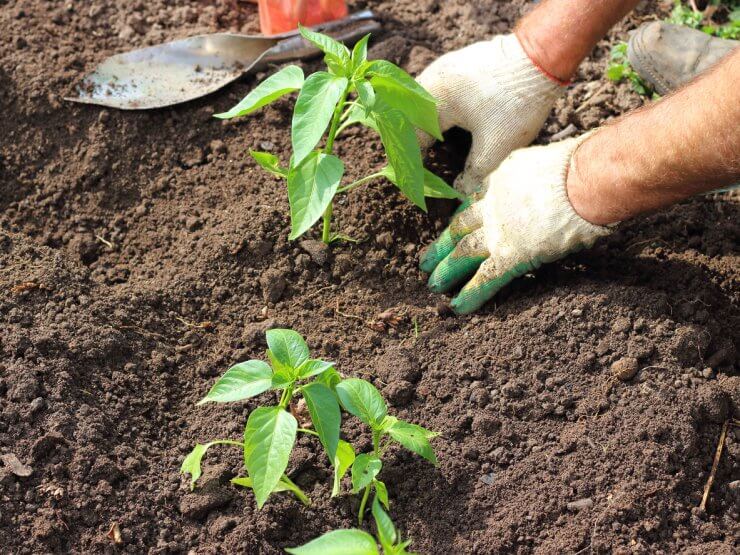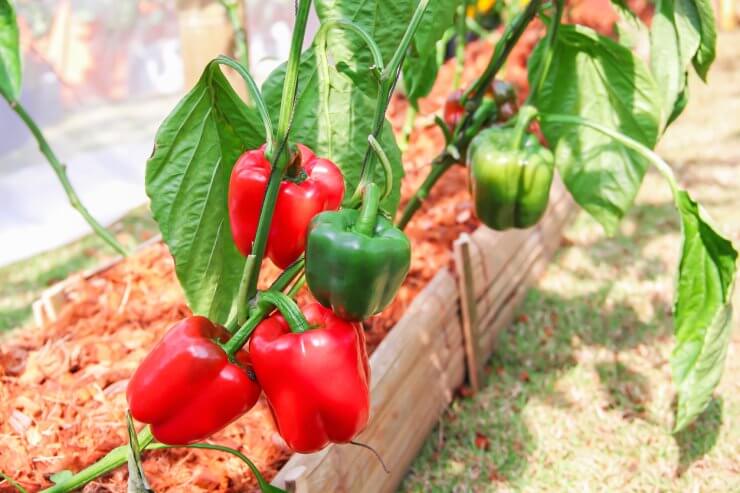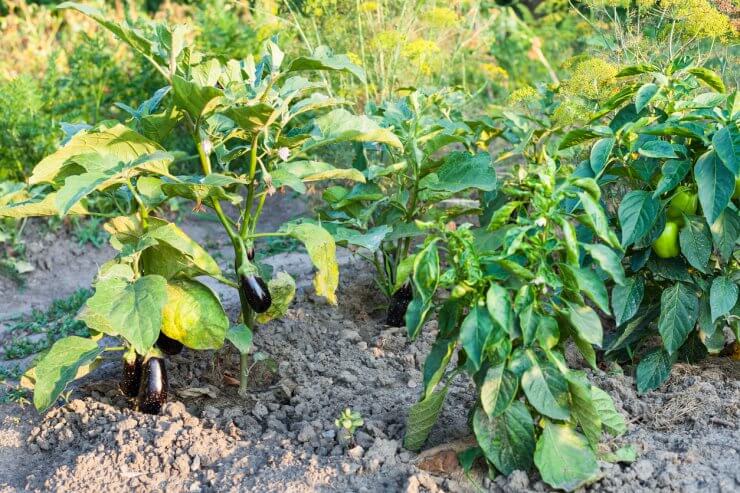
Farmer planting young pepper seedling in ground in garden
Planting
If you live in an area with a long growing season, the easiest way to plant bell peppers is to plant seeds directly in the ground. Keep in mind that bell peppers have a long growing season—sometimes up to 100 days—and that’s counting from transplant. So, unless you live in a region with a really long growing season, get your seedlings started early indoors, or get seedlings at your local garden center. Or do both: you’ll have a much broader choice of bell pepper varieties if you order seeds.
The soil temperature has to be at least 60 degrees F with daytime highs around 75 degrees F and nighttime lows around 65 degrees F. Because seedlings are susceptible to transplant shock, make sure there’s no danger of frost and that you’ve hardened off your seedlings before transplant (if you grew them yourself).
Keep the soil evenly moist during the seed germination period and throughout the growing season. Uneven watering can cause problems for your growing peppers.
Plant Spacing
If you’ve sown your seed directly, thin your seedlings to 18 inches apart when they get to be 4 to 6 inches tall and you can assess which plants look like they’ll do best. If the seedlings you’re thinning out seem viable, see if you have more space in your garden for them, or consider growing some in containers.
Your rows should be about 2 feet apart to give your plants room to grow and to give yourself some room to maneuver as you harvest. Some pepper plants get to be a couple feet tall. Because they have shallow root systems and they produce hefty fruits, you’ll want to consider providing them some support in the form of stakes and ties, or trellis system.
Raise beds

Peppers growing in a raised garden bed
A raised garden bed or planter is an excellent option for growing bell peppers if you don’t have soil that’s ideal for bell peppers (heavy clay soil, for example). Raised beds also help with drainage, which is essential for healthy bell pepper plants. You can even buy raised beds or build one yourself to fit your space. Planters should have holes in the bottom of the container and a drip tray underneath to guard against overwatering.
Watering and weeding will be easier if you have your bell peppers in a raised bed or planter. It’s a good alternative to growing in open land. And if you fill a raised bed with packaged garden soil, you know you’re providing a cleaner and healthier environment for your plants from the outset.
Packaged garden soil means less weeding than you’d have from digging a hole in the ground; and with a raised bed or container, there’s less bending down to do your weeding!
Extra Protection: Milk Jugs
Some gardeners have had success growing bell peppers by setting their seedlings out and surround each plant with a 1-gallon milk jug cut open at the bottom and the top. Cut a big X in the bottom of the jug and bend out the triangular flaps; cover those with soil to weigh down the jug. Cut the top of the jug off, too, just above the handle, to allow the plant to grow. The milk jug approach insulates the plants from temperature drops and also acts as a barrier to soil-level pests like cutworms, snails, and slugs.
Sunscald Prevention
Pepper plants love the sun, but the young growing peppers themselves don’t always appreciate blazing sun. Too much high-temperature sun exposure can lead to sunscald; it appears as off-white blotches on the peppers’ skin in areas of the plant where leaves are missing, most likely because of pests and/or disease.
Installing a floating row cover with hoops can provide some protection from the sun without completely blocking it. Inspect your plants regularly for signs of pests, disease, or other conditions. If your plants are pest- and disease-free and you don’t need to put a row cover over your entire row, you can install shade cloth for your exposed peppers to protect them from the harshest sun of the day.
Trellising
One of the challenges with crops such as bell peppers is that the fruits can really put a strain on the plant as they grow. And if you plan to grow your peppers past the green stage, you want to give them the best chance possible to make it to harvest. Trellising gives your pepper plants the support they need.
Trellising can be as simple as repurposing a tomato cage, if you’re only growing a few plants, or if you’re growing in containers. But if you have a whole row or two of pepper plants, your goal is to keep the plants upright and the fruits off the ground until harvest.
Here’s what you need to set up a basket weaving trellis system for your pepper plants, starting when the plants are about a foot tall:
- Wooden stakes, 4 to 4 1/2 feet long, with a 1-inch diameter
- Garden wire
- Sisal twine
- Optional (but helpful): Something to serve as a weaving wand (a stick with a hole in each end, a short piece of PVC pipe, a straight metal brace with a hole in each end)
- Drive your stakes about a foot deep along your row, spacing them about 3 feet apart (ideally, equally spaced between each plant) and at each end. Your posts at the end of each row should be securely anchored to support the weight of the peppers as they grow.
- Tie the end of the twine to one end post.
- Then take the twine to the first post and wrap it around the post. Be sure at each step to keep the twine taught so it can support the plant.
- Then move to the other side of the row and run the twine to the next post, wrapping it around that.
- Continue alternating sides until you reach the end of the row.
- Then work your way back along the row, this time running the twine on the other side of the pepper plant. Be sure to wind the twine around each post as you reach it—but don’t wrap the twine around your plant, or you’ll doom it.
- As the growing season progresses, add another row of twine for every foot of growth, alternating sides, to provide support for your plants while still giving them plenty of good air circulation.
Companion Planting

Bell peppers and eggplant growing as companion plants in vegetable garden
Companion planting matches plants with soil and nutrient needs different enough that they help, rather than hinder, the growth of both plants. Good companion plants can help attract beneficial insects and deter pests, from small insects to hungry herbivorous mammals like rabbits and deer. Companion planting also helps add nutrients to the soil and reduce soil erosion. If you have limited gardening space, companion planting can help you maximize your planting area, giving you another way to squeeze in one more crop.
Here are some companion plants for bell peppers and the function they serve:
Basil: Some gardeners claim that basil makes their peppers taste better, and that it can help repel aphids, spider mites, thrips, and flies.
Beets: If you garden in a zone that doesn’t get too hot, beets are a good companion plant. And fresh beets beat canned beets, hands-down.
Carrots: Peppers have shallow roots; carrots have deep roots. Talk about maximizing space! The feathery carrot fronds can also act like a living mulch, shading out weeds.
Chamomile: Think of it as a living mulch that you can eventually use to make tea.
Chard: Swiss chard can act as a windbreak and offer up a little shade for pepper plants to protect them from sunscald. Chard also does a good job of crowding out weeds, making your life a little easier.
Chives: Chives may enhance the flavor of its neighbors while also deterring aphids and other insects, which don’t like the smell of the plant.
Corn: An uncommon choice for companion planting, to be sure. But corn can offer a little shade to your pepper plants during the dog days of summer, act as a windbreak to protect your growing fruits, and work as a distraction for aphids to keep them off your pepper plants.
Dill: Dill has a reputation for attracting beneficial insects while repelling pesky ones, like aphids. It may also help improve the flavor of your pepper crop. And let’s face it, dill just looks nice in the garden.
Eggplant: Yes, it’s another member of the nightshade family, just like peppers, so you never want to plant them one after the other, season to season. But planted together, they complement each other—plus you get more fresh produce from your garden. Be aware, though, that all members of the nightshade family attract similar pests. So add in some smaller companion plants as protection.
Garlic: Garlic acts as a deterrent to aphids and some beetles, protecting your peppers. It also gives you a way to sneak in another crop with minimal fuss.
Geraniums: You’re not going to eat them, but they’ll do their part to attract pollinators and repel cabbage worms, Japanese beetles, and other pests. They also provide a great pop of color in the garden.
Leeks: Leeks have a reputation for deterring carrot flies and other pests. They don’t take up much room, and they are as delicious as their cousins garlic and onion.
Lettuce: Lettuce can help crowd out weeds while it provides you with some fresh salad makings.
Marigolds: French marigolds have a longstanding reputation for repelling aphids, nematodes, slugs, and whiteflies. Word has it that they may also promote the growth of nearby crops. Plus, you can eat them.
Nasturtium: Nasturtiums have a reputation for being aphid magnets, so they can keep those pests away from your peppers. They may also repel beetles and squash bugs. If the flowers are aphid-free come pepper harvest time, you can use them as a garnish on your salad.
Okra: Okra works well as a windbreak and can offer a little shade to growing pepper plants during the hottest days of summer. It may also deter aphids.
Onions: Onions don’t take up a lot of space (compared to the sprawling pepper plants), and they may help repel aphids, slugs, and cabbage worms.
Oregano: Have a little space between your pepper plants? Plant some oregano. The two will get along in the garden—and in sauces and salads.
Parsley: Parsley offers up a little shade in the garden, and a little flavor in the kitchen.
Parsnips: This root veggie fits nicely between or among your pepper plants. You can probably come up with a good recipe to use the two together!
Petunias: Petunias repel leafhoppers, tomato worms, and aphids. And they’re beautiful.
Radishes: Radishes are super-easy to grow—and they grow fast! This is your chance to sneak in an additional harvest in those in-between spaces.
Spinach: Spinach doesn’t take up much space, and it can crowd out weeds while staying out of the way of growing pepper plants. Plus, it’s delicious.
Squash: Summer and winter squash work well as bell pepper neighbors, offering up their broad leaves to shade out weeds while shading your peppers from sunscald.
Tomatoes: OK, when it comes to crop rotation, planting tomatoes or peppers after each other is a big gardening no-no. However, you can plant them as garden bed buddies in the same season. Just be sure to rotate them out of there for the next season. Tomatoes can help shade out weeds and offer peppers a little respite from the heat of the day. One word of warning: tomatoes are susceptible to the same pests and diseases as peppers, so you want to give each plant its own space. You should also plant some low-profile plants that repel aphids and other pests that like peppers and tomatoes.
How do you plant your bell peppers? What criteria for site selection has worked for you? Do you grow companion plants with your bell peppers? Do you find it’s helpful to stake or trellis your pepper plants to support them as they grow? Please share your ideas with us.


 Previous
Previous

